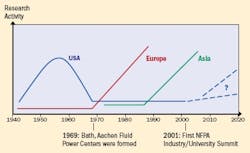Is fluid power research returning to its heyday?
The familiar beep of an e-mail on my computer pops me back into reality. Maybe this one is a follow-up to my request for more information on a new hydraulic hybrid vehicle drive. Or maybe it's correspondence with an image attached showing the latest hydraulic fan drive. Then again, it might be a manuscript about a multifunctional hydraulic system that is lighter, smaller, and more efficient than the electric drives it replaces. But it may also explain how replacing multiple engine-driven belt drives with a single hydraulic system can slash maintenance costs.
All of these scenarios — and more — are in the works. And in my 20+ years working on H&P, I have never heard of so much activity occurring at the same time.
In addition, the U. S. appears to be at the forefront of renewed activity in fluid power research. Kim A. Stelson, director, Engineering Research Center for Compact and Efficient Fluid Power at the University of Minnesota, authored a paper outlining the amount of investment in fluid power research across the globe. As a graphic from that paper depicts, the U. S. led the world in fluid power R&D for two decades following WWII, and activity peaked in the 1960s before dropping off sharply around the same time R&D ramped up in Europe.
Since then, the majority of large-scale research has occurred overseas. But as Kim's graphic implies, activity in fluid power research in the U. S. gained new momentum with the first NFPA Educator-Industry Summit launched in 2001, and more recently with the $15 million, 5-year Fluid Power Research Center awarded by the National Science Foundation.
So with all the new developments in fluid power technology, the Educator-Industry Summit, and the Fluid Power Research Center, things are really looking up for fluid power technology. And who knows? Maybe future generations will refer to the early 21st century as the heyday for fluid power.
About the Author
Alan Hitchcox Blog
Editor in Chief
Alan joined Hydraulics & Pneumatics in 1987 with experience as a technical magazine editor and in industrial sales. He graduated with a BS in engineering technology from Franklin University and has also worked as a mechanic and service coordinator. He has taken technical courses in fluid power and electronic and digital control at the Milwaukee School of Engineering and the University of Wisconsin and has served on numerous industry committees.

Leaders relevant to this article:

